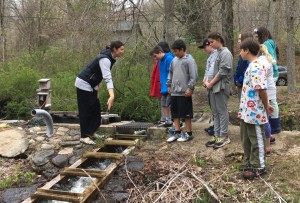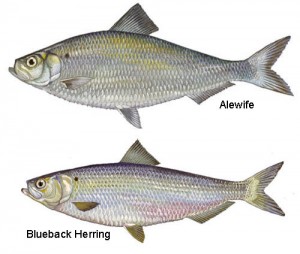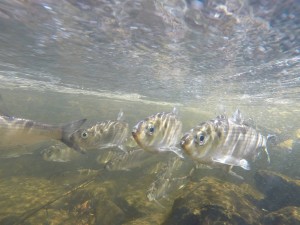A fish ladder is an artificial stepladder of water that provides passage for migrating fish and eels around a dam.
 Lyme Consolidated School 5th Graders celebrated Earth Day 2016 by taking a short field trip with the Lyme Land Trust to the Moulson fish ladder. Thank you to all of our volunteers who helped make this possible – Eliza Sharp, Emily Bjornberg, and Sue Cope. A special thank you to our hosts Sue Hessel and Karen Dahle. Photo by Eliza Stark.
Lyme Consolidated School 5th Graders celebrated Earth Day 2016 by taking a short field trip with the Lyme Land Trust to the Moulson fish ladder. Thank you to all of our volunteers who helped make this possible – Eliza Sharp, Emily Bjornberg, and Sue Cope. A special thank you to our hosts Sue Hessel and Karen Dahle. Photo by Eliza Stark.
The Moulson Pond Fishway on the Eightmile River has successfully provided passage for migrating fish and eels around the old mill dam for many years. Since 1998, when the Fishway was installed, thousands of fish have been observed passing around the dam to swim upstream to their ancestral spawning grounds. Since 2015, a newly installed camera has been able to give us an accurate count of the fish that traveled this way. According to Tim Wildman, DEEP fisheries, in 2015 the Moulson Pond Fishway passed 11, 587 fish. It facilitated the upstream migration of 11,690 Blueback Herring, the largest count in the state of Connecticut. Only 72 alewife were counted and 19 shad. One unexpected treat was an American Salmon. Scroll down to see a video of the migrating fish. For more information about migrating fish and the fish ladder. Photo: Alewives at Moulson Pond Fishway on the Eightmile River, courtesy of DEEP Inland Fisheries, Diadromous Fisheries Restoration
River herring, the main group that we see using the fish ladder, are actually two species of anadromous fish that are about a foot long, alewife and blueback herring. Anadromous fish, which also includes Shad and Salmon, spend most of their lives in the ocean but must swim up rivers and streams to reproduce in fresh water. The success of river herring is essential. They serve as forage fish for larger predators in a widespread ecosystem that extends from Lyme into the Long Island Sound and beyond into the oceans.
In recent years the populations of anadromous fish has dramatically plummeted. Dams contribute to this decline by preventing the fish from reaching the best habitat for reproduction. In cases where the dams can’t be removed, fish ladders have been effective in allowing fish a way around.
Many volunteers monitor the fish ladder daily during the migration season and estimate the number of fish that pass through. In the spring of 2014, a video camera was installed at the Moulson Pond Fishway to count the number of fish and eels that use the fish ladder. This counter allows scientists at DEEP to obtain accurate counts of fish moving upstream.
Here is a video clip of the Moulson Pond Fishway camera from Spring 2015
May 6, 2015: Mostly blueback herring, some large shad and a couple of other fish
Financing for the camera came from Trout Unlimited.
Ed Bill’s Pond Dam on the Eightmile River by Salem Road was removed in 2015. The fish ladders there was are not successful. To read more about the dam removal, The Day: Ed Bill’s Dam removal. For an NPR report about how the dam removal at Ed Bill’s Pond will restore the environment, click here.







